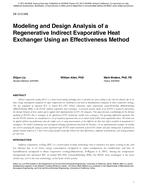
DE-13-C048 — Modeling and Design Analysis of a Regenerative Indirect Evaporative Heat Exchanger Using an Effectiveness Method
- Comments Off on DE-13-C048 — Modeling and Design Analysis of a Regenerative Indirect Evaporative Heat Exchanger Using an Effectiveness Method
- ASHRAE
Indirect evaporative cooling (IEC) is a water-based cooling technology that is attractive for space cooling in dry and hot climates due to itslower energy consumption (compared to vapor compression air conditioners) and lack of humidification (compared to direct evaporative cooling).The key component of advanced IEC or hybrid IEC/DX (Direct eXpansion vapor compression) systems(Elberling 2006)(Elberling2006)(Elberling 2006) is the IEHX (indirect evaporative heat exchanger). A practical accurate model of an IEHX is needed to characterizethe thermal behavior of these coolers and to support their implementation by HVAC designers. This paper presents a methodology for the thermalmodeling of IEHXs that is analogous to the effectiveness-NTU method for sensible heat exchangers. The governing differential equations thatdescribe IEHX behavior are transformed to a set of analytical equations that can be solved stably within short computation times. The model canbe applied without any performance data for simple cases, or using measurements at two different air flow rates (often available in manufacturers’catalogues). The model’s performance was investigated utilizing experimental data from the literature. As an implementation example, the methodwas used to analyzing the sizing of a plate regenerative-type IEHX under constraints of fixed HX volume and space cooling load. It produced anoptimal channel height of 2-3 mm to best satisfy specified trade-offs between wet bulb effectiveness, coefficient of performance, and cooling producedper unit area.
Citation: ASHRAE Conference Papers, Denver, CO
Product Details
- Published:
- 2013
- Number of Pages:
- 9
- File Size:
- 1 file , 1.6 MB
- Product Code(s):
- D-DE-13-C048

